Abstract
In analysing human papilloma virus (HPV) infection of the cervix in formalin fixed paraffin sections by non-isotopic in situ hybridisation two main problems were found: detachment of sections from the glass during hybridisation and probe detection; inadequate sensitivity and inability to assess sensitivity of the in situ procedure. The first problem was investigated by assessing the efficiency of various tissue adhesives individually and in combination. The second problem was addressed by optimising conditions for DNA unmasking, hybridisation, and biotinylated probe detection. Sensitivity of the final in situ procedure developed was assessed by using the detection of pHY2.1 repeats as a built-in control. Extrapolation of data showed that less than 10 copies of HPV DNA can be visualised by these procedures. HPV nucleic acid, mainly in the form of DNA, was detected not only in koilocytic nuclei but also in suprabasal cells in condylomas and CIN lesions. HPV mRNA was also visualised in the cytoplasm (and probably also nuclei) of the same cell types. These non-isotopic in situ procedures give results comparable to those obtained with radiolabelled probes, but they are less time consuming and provide better morphological resolution.
Full text
PDF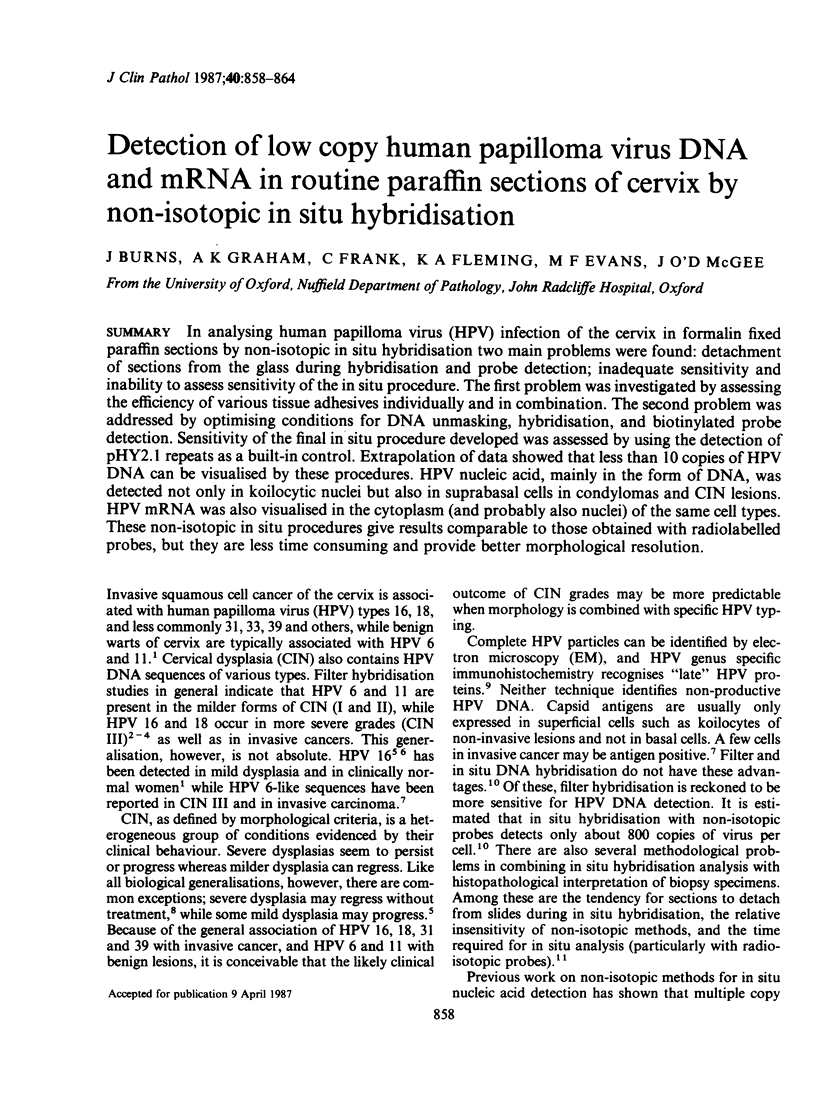


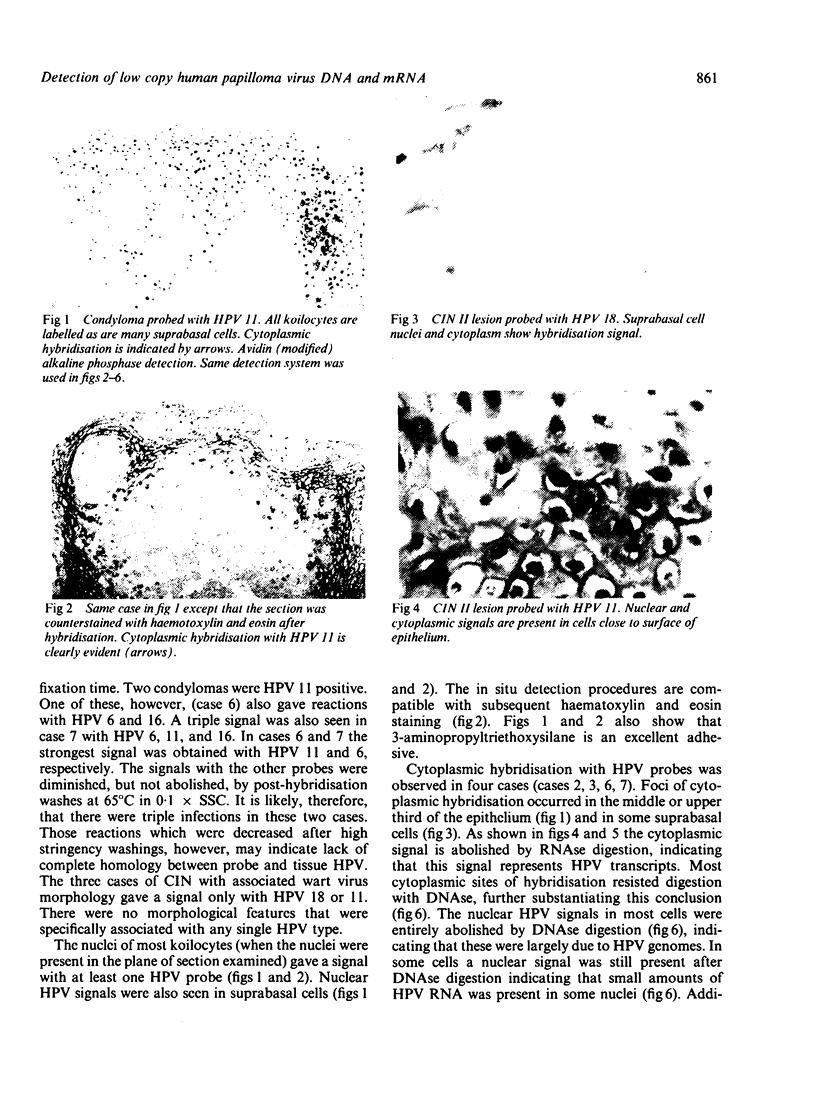
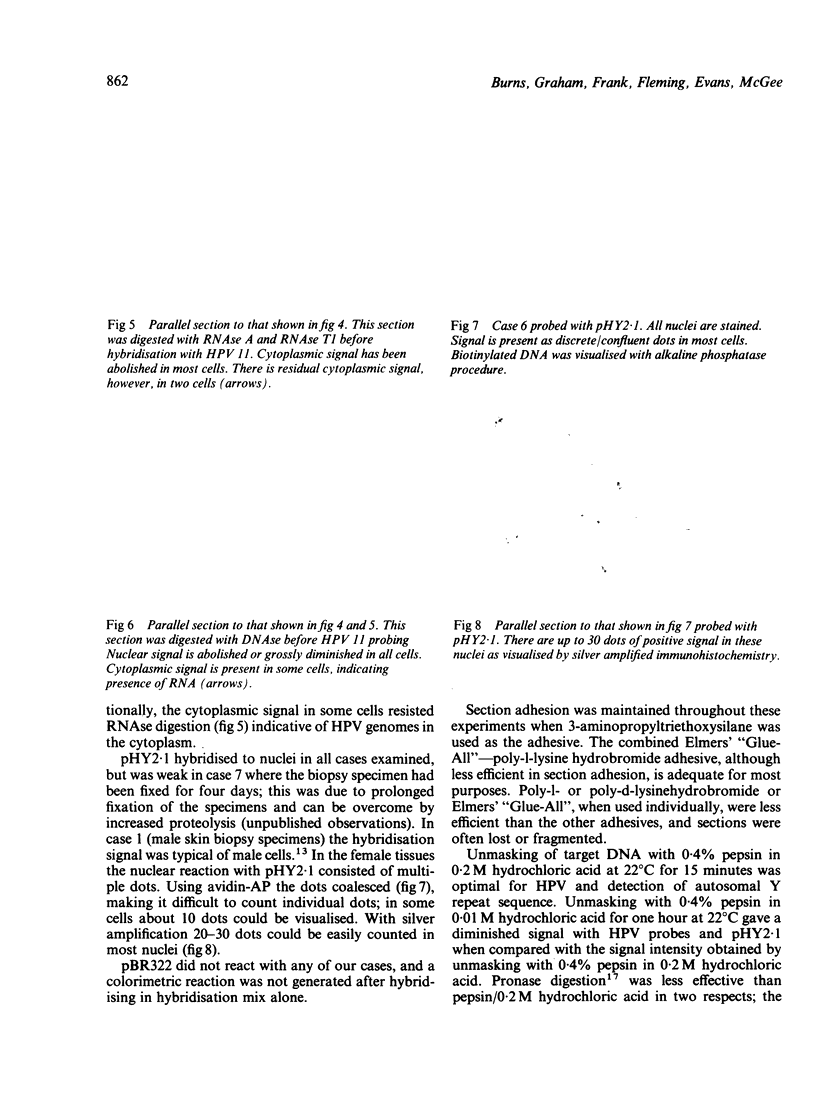
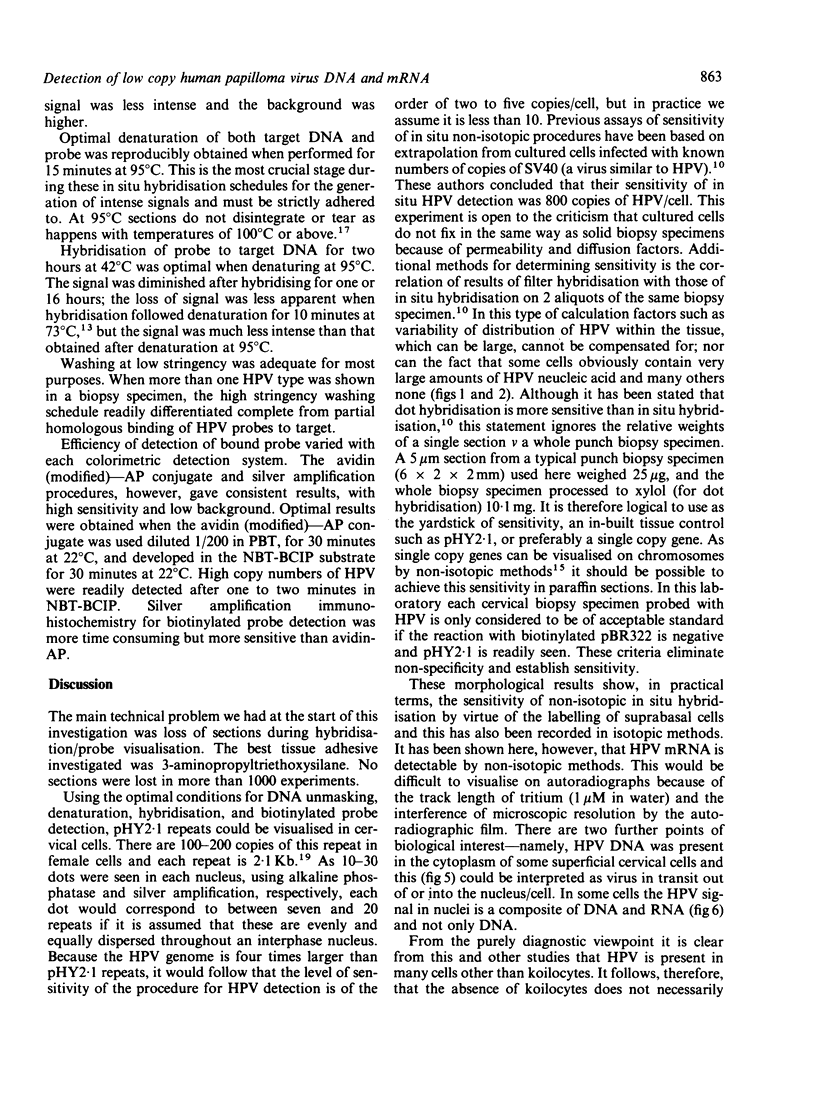
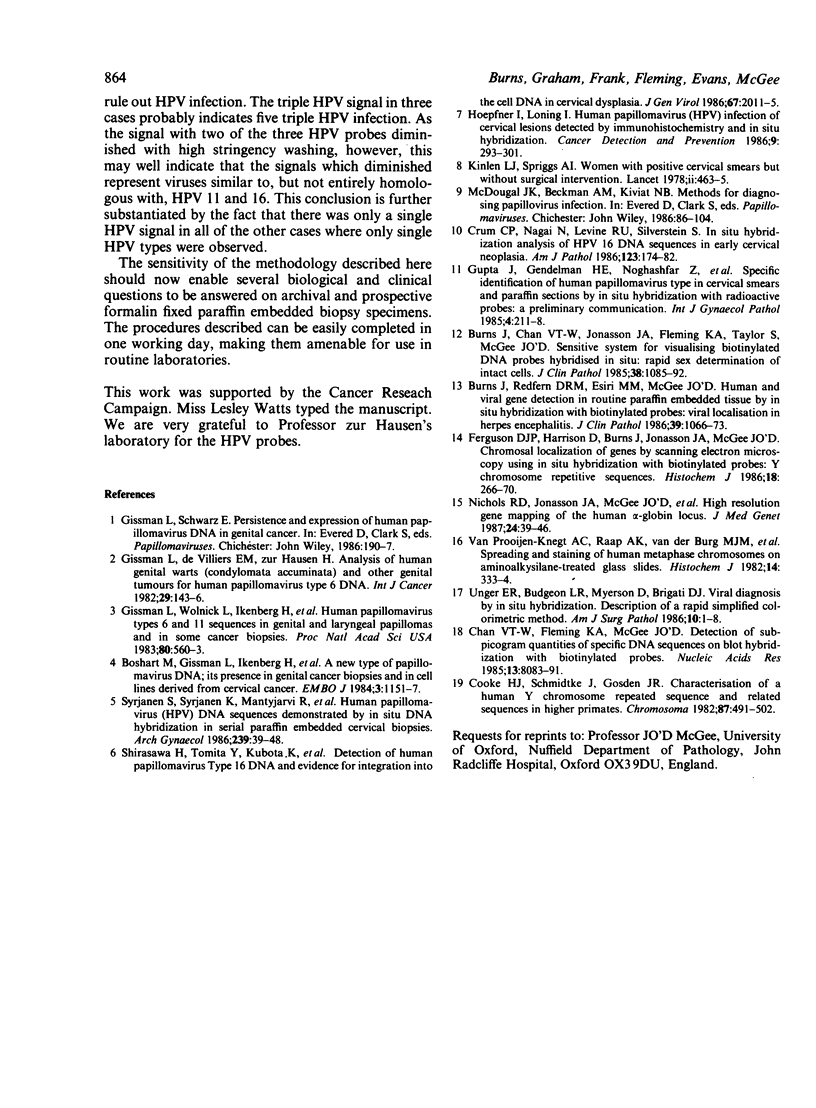
Images in this article
Selected References
These references are in PubMed. This may not be the complete list of references from this article.
- Boshart M., Gissmann L., Ikenberg H., Kleinheinz A., Scheurlen W., zur Hausen H. A new type of papillomavirus DNA, its presence in genital cancer biopsies and in cell lines derived from cervical cancer. EMBO J. 1984 May;3(5):1151–1157. doi: 10.1002/j.1460-2075.1984.tb01944.x. [DOI] [PMC free article] [PubMed] [Google Scholar]
- Burns J., Chan V. T., Jonasson J. A., Fleming K. A., Taylor S., McGee J. O. Sensitive system for visualising biotinylated DNA probes hybridised in situ: rapid sex determination of intact cells. J Clin Pathol. 1985 Oct;38(10):1085–1092. doi: 10.1136/jcp.38.10.1085. [DOI] [PMC free article] [PubMed] [Google Scholar]
- Burns J., Redfern D. R., Esiri M. M., McGee J. O. Human and viral gene detection in routine paraffin embedded tissue by in situ hybridisation with biotinylated probes: viral localisation in herpes encephalitis. J Clin Pathol. 1986 Oct;39(10):1066–1073. doi: 10.1136/jcp.39.10.1066. [DOI] [PMC free article] [PubMed] [Google Scholar]
- Chan V. T., Fleming K. A., McGee J. O. Detection of sub-picogram quantities of specific DNA sequences on blot hybridization with biotinylated probes. Nucleic Acids Res. 1985 Nov 25;13(22):8083–8091. doi: 10.1093/nar/13.22.8083. [DOI] [PMC free article] [PubMed] [Google Scholar]
- Cooke H. J., Schmidtke J., Gosden J. R. Characterisation of a human Y chromosome repeated sequence and related sequences in higher primates. Chromosoma. 1982;87(5):491–502. doi: 10.1007/BF00333470. [DOI] [PubMed] [Google Scholar]
- Crum C. P., Nagai N., Levine R. U., Silverstein S. In situ hybridization analysis of HPV 16 DNA sequences in early cervical neoplasia. Am J Pathol. 1986 Apr;123(1):174–182. [PMC free article] [PubMed] [Google Scholar]
- Ferguson D. J., Burns J., Harrison D., Jonasson J. A., McGee J. O. Chromosomal localization of genes by scanning electron microscopy using in situ hybridization with biotinylated probes: Y chromosome repetitive sequences. Histochem J. 1986 May;18(5):266–270. doi: 10.1007/BF01676236. [DOI] [PubMed] [Google Scholar]
- Gissmann L., Wolnik L., Ikenberg H., Koldovsky U., Schnürch H. G., zur Hausen H. Human papillomavirus types 6 and 11 DNA sequences in genital and laryngeal papillomas and in some cervical cancers. Proc Natl Acad Sci U S A. 1983 Jan;80(2):560–563. doi: 10.1073/pnas.80.2.560. [DOI] [PMC free article] [PubMed] [Google Scholar]
- Gissmann L., deVilliers E. M., zur Hausen H. Analysis of human genital warts (condylomata acuminata) and other genital tumors for human papillomavirus type 6 DNA. Int J Cancer. 1982 Feb 15;29(2):143–146. doi: 10.1002/ijc.2910290205. [DOI] [PubMed] [Google Scholar]
- Hoepfner I., Löning T. Human papillomavirus (HPV) infection of cervical lesions detected by immunohistochemistry and in situ hybridization. Cancer Detect Prev. 1986;9(3-4):293–301. [PubMed] [Google Scholar]
- Kinlen L. J., Spriggs A. I. Women with positive cervical smears but without surgical intervention. A follow-up study. Lancet. 1978 Aug 26;2(8087):463–465. doi: 10.1016/s0140-6736(78)91457-5. [DOI] [PubMed] [Google Scholar]
- Nicholls R. D., Jonasson J. A., McGee J. O., Patil S., Ionasescu V. V., Weatherall D. J., Higgs D. R. High resolution gene mapping of the human alpha globin locus. J Med Genet. 1987 Jan;24(1):39–46. doi: 10.1136/jmg.24.1.39. [DOI] [PMC free article] [PubMed] [Google Scholar]
- Syrjänen S., Syrjänen K., Mäntyjärvi R., Parkkinen S., Väyrynen M., Saarikoski S., Castren O. Human papillomavirus (HPV) DNA sequences demonstrated by in situ DNA hybridization in serial paraffin-embedded cervical biopsies. Arch Gynecol. 1986;239(1):39–48. doi: 10.1007/BF02134287. [DOI] [PubMed] [Google Scholar]
- Unger E. R., Budgeon L. R., Myerson D., Brigati D. J. Viral diagnosis by in situ hybridization. Description of a rapid simplified colorimetric method. Am J Surg Pathol. 1986 Jan;10(1):1–8. doi: 10.1097/00000478-198601000-00001. [DOI] [PubMed] [Google Scholar]
- van Prooijen-Knegt A. C., Raap A. K., van der Burg M. J., Vrolijk J., van der Ploeg M. Spreading and staining of human metaphase chromosomes on aminoalkylsilane-treated glass slides. Histochem J. 1982 Mar;14(2):333–344. doi: 10.1007/BF01041225. [DOI] [PubMed] [Google Scholar]










